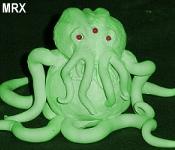On the heels of my return to the lathe, following my successful attempt at creating turned wooden pendulums, I thought I would try my hand at turning something other than a spindle shape. The easiest thing to start with was a bowl.
I like using reclaimed wood for projects. Probably because I'm a cheap bastard who doesn't like paying a lot for supplies. But also because I can't stand to see anything useful get thrown out and wasted. This bowl was a test project, so I was definitely not going to use good wood for it. I found this wood in the garbage. The thick lighter pieces were from a reclaimed cheap bed frame (probably pine or fir), and the thinner darker strip in the middle was straight out of my scrap bin.
I sanded the faces as flat as I could get them, without a planer or jointer or drum sander, so that they would glue up without any gaps. Then I sandwiched them together with wood glue and clamped them for a couple of hours.
Using another piece of scrap wood, I made a sacrificial glue block and attached it to a face plate, which will screw onto the head stock of my lathe.
Then I trimmed the corners off of the blank with the band saw, just to make getting it round a little easier.
I attached the glue block with some super glue, which will be challenging but not impossible to remove from the base once it is finished.
Then, start rounding it out and shaping the exterior.
The center layer of wood was not a solid block, but a square ring of smaller pieces, so once I broke through the top layer of the block, there was a void beneath it.
After shaping, came sanding. Sanding always takes longer than I think it will. Maybe because my turning technique is weak (and my tools are not as sharp as the should be). I start with 80 grit sand paper and then go through 120, 320, 500 and 1000. I can still do a little shaping with everything through 500. The 1000 grit is basically just polishing.
After sanding comes finish. I like to apply my finish right on the lathe whenever possible. For this, I used a friction polish that some call O.B.'s Shine Juice. It is 1 part boiled linseed oil, 1 part shellac, and 1 part denatured alcohol. It is applied with a paper towel in thin coats, with the lath turning , and buffed immediately between coats with a dry paper towel. The heat from the buffing dries the finish in seconds and it is ready for another coat. I usually apply 5 or 6 coats.
The last step was to part the bowl from the glue block. I started by separating it near the joint with a parting tool, then when the connection was small and weak, I was able to pop the rest of the superglue loose by hand. Then I sanded the bottom of the bowl smooth and applied a couple coats of Shine Juice (off the lathe) and buffed with a paper towel.
The picture below makes the bowl look more yellow than it really is. I think the blue rag messed with the camera's color balance. Although, the Shine Juice will impart a very slight yellow to the wood from the shellac and BLO.
This is a much more accurate depiction of the color.
Wood turning is fun, but it does make a hell of a mess!
Tombfire Wands
-
McCormick Wands returns to our pages with these beautiful Tombfire wands,
carved from maple and purpleheart. I love the rich organic textures.
2 days ago



































No comments:
Post a Comment